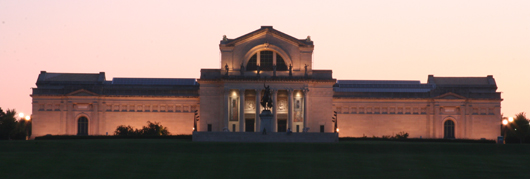
ST. LOUIS (AP) – The St. Louis Art Museum’s new expansion puts its collection in a new light – literally. The wing’s one-of-a-kind grid of skylights and floor-to-ceiling windows illuminate the artworks naturally. The effect is more “honest,” says museum registrar Jeanette Fausz.
“When you do electric light, it does add some color, and that is the element we are removing in these galleries,” said Fausz. “We are allowing you to see it with natural light and bring that color to a more honest look.”
Museum officials offered a sneak peek at the 200,000-square-foot expansion on Dec. 4. Curators will start installing art early next year; the public gets its first look during a two-day festival June 29-30.
Though a growing number of museums use natural light to showcase their collections, the museum’s skylight system is one of a kind, says Roger McFarland of HOK, the St. Louis architectural firm that provided technical assistance to British architect David Chipperfield. The glass walls also won’t tint incoming sunlight. The result is an experience that changes with the weather.
“If you are here on a sunny day and a cloud goes through, you feel it in the gallery,” said McFarland, adding artificial light can be used in the evening and gray days. “You’re going to see the paintings in different colors of light based on the sun.”
The wing includes a 300-space parking garage, energy-efficient heating and cooling systems, climate controls to better preserve delicate objects and a 100-seat restaurant. But most importantly, it delivers space. Currently, 94 percent of the museum’s 33,000-object collection is locked in storage.
“The driving force behind this is the need for more space,” said Director Brent Benjamin. “We have a great number of works that haven’t been on view in more than a decade. We have some works that have always been in storage. So every collection gets to loosen its belt a notch or two and have more space for works to be installed.”
The museum will remain free, though there will be a fee to park in the new lot. The museum will continue to charge for touring exhibitions.
Benjamin said the expansion’s 21 new galleries will feature about 250 works from the 20th and 21st century. It also will host special exhibits. The first show, “Postwar German Art in the Collection,” will open in June and feature major works from Gerhard Richter, Sigmar Polke, Anselm Kiefer and others.
“Name virtually any American or German artist of the postwar era that is in our collection and he or she will be on view here in the expansion,” said Benjamin, noting the galleries can accommodate taller and bigger works than the museum’s existing galleries.
The expansion has taken almost three years to complete and cost $162 million. Benjamin said Chipperfield’s design both honors Forest Park and the Cass Gilbert-designed building.
“Instead of giving us a wing that is independent of the main body, he actually has given us an expansion that is organically linked to the facility,” Benjamin said. “It didn’t start that way. It seems very obvious and organic now that we see it, but it took a year of chasing this project around the building – where would it be, how would it connect, would it be low, would it be high?”
Though the light white oak floors and abundant natural light create an airy atmosphere, the polished stone facade and concrete-grid ceiling convey gravitas. The exterior is composed of 23 panels of highly polished Missouri and Wisconsin river aggregate. Each panel weighs between 44,000 and 84,000 pounds. The ceiling is formed from 1,600 cubic yards of poured concrete.
“It’s a building that is about mass, about weight,” Benjamin said. “So much of contemporary museum architecture is about lightness and transparency but this is a building about mass because the Cass Gilbert building is a great big pile of stone. Whatever was going to be here needed to stand up to it in terms of massiveness and weight. That is quite an accomplishment. In many ways it’s very deferential but it has a character of its own and lives very comfortably side by side.”
Copyright 2012 Associated Press. All rights reserved. This material may not be published, broadcast, rewritten or redistributed.
AP-WF-12-10-12 1545GMT
ADDITIONAL IMAGE OF NOTE


